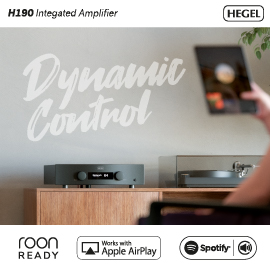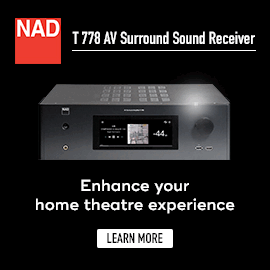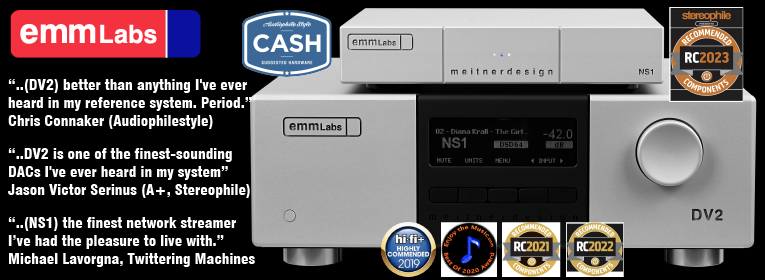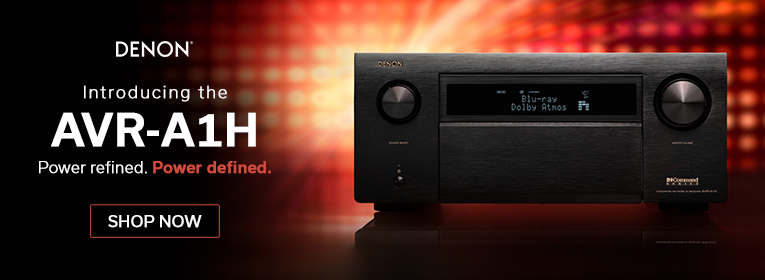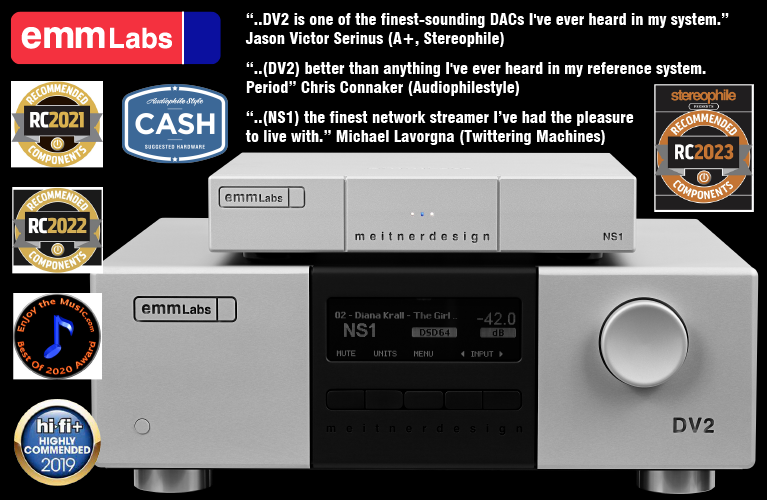
 If the name Hegel Music Systems is new to you, it might be because of where you live -- here in Canada, Hegel products have become readily available only in the last few years. But Hegel is a long-established firm with a strong track record. It was founded in Norway in 1988 by chief designer Bent Holter, and all their products are still manufactured there.
If the name Hegel Music Systems is new to you, it might be because of where you live -- here in Canada, Hegel products have become readily available only in the last few years. But Hegel is a long-established firm with a strong track record. It was founded in Norway in 1988 by chief designer Bent Holter, and all their products are still manufactured there.
Nor is Hegel’s HD10 digital-to-analog converter brand new. The less expensive HD2 DAC ($350 USD), as well as the more expensive HD20 ($2000), have been launched since the HD10 was introduced in 2009, but the still-current HD10 occupies an important place in the Hegel line for its high performance and low price ($1200). It’s the kind of product a serious audiophile on a regular income can afford.
Description
Like most Hegel products, the HD10 has a modest, elegant appearance and is relatively small: about 8.25”W x 2.5”H x 10.25”D, and weighing just over six pounds. But it’s well built, with a black, all-metal case that feels sturdy. The HD10 ships with its own basic black power cord, but the IEC-compatible AC inlet on its rear panel means that aftermarket cords can be swapped in. For this review, I used Hegel’s basic cord.
Hegel claims that the HD10 is a fully balanced design; that is, much of its circuitry is duplicated in a symmetrical fashion in order to reduce noise and distortion. The rear panel has balanced as well as single-ended analog outputs, but it stands to reason that the best sound will be had with a balanced connection. I tried both types of output connection and found the sounds to be nearly identical. Still, if pressed about all-out performance, I’d give the nod to the balanced connection, and recommend using it that way if the rest of your system allows.
At the heart of the HD10 is an Analog Devices AD1955 DAC chip that will accept digital signals of resolutions up to 24-bit/192kHz through either of the two RCA-based S/PDIF inputs on the rear panel. The TosLink connector accepts only up to 24/96, the adaptive-mode USB input to 16/48. Selecting among the four digital inputs (Coax 1 and 2, Optical, USB) is done using the single large pushbutton on the front panel.

The 16/48 limit via USB is a shortcoming, given that there are DACs on the market, including Hegel’s own HD2 and HD20, that support up to 24/96 via USB, and others that go as high as 24/192. If you don’t use a computer as a source component, then the USB limitation won’t matter. But if you do use a computer with the HD10, as more and more audiophiles (including me) are opting to do, how much of a shortcoming it will be will depend on: 1) the amount of high-resolution music you listen to (CD resolution is 16/44.1, so it’s within the HD10’s scope), and 2) whether or not you mind using a third-party USB-to-S/PDIF converter that can allow those higher resolutions via the coaxial inputs. The latter is what I did, using my mainstay, Blue Circle Audio’s USB Tunnel 24/96 (which accepts up to 24/96), as well as Stello’s new U3 (which just arrived for review and accommodates up to 24/192). These converters were connected to my Sony Vaio laptop computer. Of course, the addition of an outboard converter will increase the overall cost.
Any incoming digital signal of less than 24/192 resolution is automatically asynchronously upsampled to 24/192 by the Hegel HD10. Sometimes asynchronous upsampling can have a deleterious effect on the sound (this depends a lot on the algorithm/process used), but Hegel feels that any negative effects of upsampling are offset by the HD10’s internal DAC operating at its optimal bit depth and sampling frequency of 24/192.
Performance
The first piece of music I play through almost any component I review is “5 Days in May,” from Blue Rodeo’s Five Days in July (16/44.1 FLAC, Discovery). This very good pop/rock recording from 1993 has natural-sounding instrumental and vocal timbres, a great soundstage spread with a true sense of acoustic space, and precise imaging. Overall, it sounds real, and very much like a live band playing in my room.
Listening to this track, the first thing that struck me about the HD10 was how exceedingly clean it sounded -- the band’s singers, in particular, sounded very natural, with a resounding clarity that made them highly focused and quite present on the stage. The next thing I noticed was how low the noise floor was. Not only did the voices sound pristine; the guitars were crystal clear, the drums were rendered with clean, visceral impact, and all the music emerged from a background of complete aural “blackness.” The overall sound was so transparent that I knew the HD10 was performing at a higher level than its price indicated. Normally, with an affordably priced converter, I expect to hear just a touch of edge, a little bit of grunge, and not quite the transparency the HD10 was giving. Instead, the HD10 possessed the kind of ultraclean, thoroughly precise sound I expect from DACs costing multiples of its price.
The dynamics also impressed me -- the HD10 had a visceral, punchy sound that made music really come alive. The thwack of the drums, the presence in Greg Keelor’s and Jim Cuddy’s voices, the pluck of the guitars -- all were vividly and incisively rendered. The HD10 sounded not only clean but lightning quick -- and, when the music had impact, ultra-immediate and super-authoritative. These qualities made Five Days in July’s inherently “live” sound seem all the more real. I don’t know for sure what accounted for these impressive dynamics, but I feel that part of it had to do with the HD10’s clarity, detail, and lack of self-noise -- against those “black” backgrounds, the contrasts between the quietest and loudest sounds were all the more apparent.
The HD10 had other strengths: a dead-neutral tonal balance, very deep bass, extremely extended highs, razor-sharp imaging, and enough texture in the bass and mids that no recording sounded lean. “5 Days in May” and the tracks that followed sounded as good as I’ve heard them through other topflight digital sources. That’s not to say the HD10 sounded exactly the same as every other DAC (more about this below), but that the sound quality was first-rate -- high praise for something I’d assumed would be nothing more than a modest, “affordable” DAC.

Bruce Cockburn’s new album, Small Source of Comfort (16/44.1 FLAC, True North), has become a staple in my review queue for a number of reasons. It is a generally good-sounding recording with a very natural and present sound, including a fine capturing of Cockburn’s husky voice. It also possesses a credible studio-created soundstage spread -- not quite as natural sounding as that of Five Days in July, but pretty good. But SSoC has flaws -- mostly compression (i.e., a lack of dynamic range), particularly in the drums, which varies from track to track. This compression isn’t the kind of thing you’d notice playing this track in the car, or through an iPod or even a small sound system, but it’s painfully obvious played through a high-enough-resolution system such as most audiophiles have. I use this recording to hear how faithfully a review product reproduces its good and bad points.
The natural timbres of SSoC were rendered with the same accuracy as with the Blue Rodeo recording, and despite the HD10’s dynamic prowess and overall lively sound, it didn’t cover up the compression that’s inherently there. But the level of detail the HD10 unraveled was extraordinarily good, and I liked the way it presented Cockburn’s voice: with an appropriate amount of presence. The HD10 reproduced this recording’s strengths as well as I’ve heard them, without covering up its weaknesses. All told, the HD10 again proved to be a startlingly clear, highly revealing, exceptionally refined device.
To get a good feel for a review product’s imaging specificity, I like to play “Everest,” from Ani DiFranco’s mostly acoustic Up Up Up Up Up Up (16/44.1 FLAC, Righteous Babe). This is something I can hear with other recordings, but “Everest” has some unique qualities: DiFranco’s voice is focused precisely in the left part of the stage, just back of the left speaker’s baffle and a little bit inside. Her voice should emanate from a point in space that doesn’t “pull” to the left speaker, with a certain amount of “musical air” around it, sort of like a halo. At the beginning of the track, a male voice can be heard counting at center stage, but distinctly farther back than DiFranco’s. The HD10 superbly rendered these illusions of depth and width, DiFranco’s voice occupying the exact size and space in the stage that it should, with the usual amount of surrounding air that I hear with a good digital source component, and with the male voice properly placed at the back of the stage, clearly separated from DiFranco’s.
As with the many other recordings I played, I could find little or no fault in the HD10’s reproduction of the other tracks on Up Up Up Up Up Up, at least for the $1200 asking price. In fact, when I reviewed my listening notes, I was taken aback to see that everything I’d written was positive. Even today, as I write this, I can’t find anything truly negative to say about the Hegel HD10, other than that its USB input is limited to 16/48, which can be overcome in other ways. The HD10’s level of performance in my system was so high that I grew curious about what, at nearly twice the price, Hegel’s HD20 DAC might sound like -- and, of course, how the HD10 would stack up against the competition.
Low- and high-priced comparisons
These days, competition among DACs is heavier than ever. So I first pitted the Hegel HD10 against the built-in DAC in Simaudio’s Moon 350P preamplifier, which is a $500 at-purchase add-on (with a moving-magnet/moving-coil phono stage, quite a deal). As in the HD10, the 350P DAC’s USB input is limited to 16/48, but the Simaudio can accept higher-resolution signals via other inputs.
The 350P’s built-in DAC is very good for the price, and its performance in terms of bass and high-frequency extension, neutrality, and midband presence is comparable to the HD10’s. But the Hegel was better in terms of clarity, refinement, and resolution -- I could hear into the recording more, and it sounded cleaner overall. That’s not to say that the 350P’s DAC sounded coarse; it just didn’t have the HD10’s sonic polish, and certainly not its resolution -- music played through the HD10 had a clarity and ease associated with cost-no-object products, not entry-level gear. As a result, the HD10 was a clear step up in performance from the Simaudio Moon 350P that was commensurate with the difference in price.
Given my comments about cost-no-object products, I thought it fitting to next go way upmarket, to the best digital source I had on hand: Simaudio’s Moon Evolution 650D DAC/transport ($8000). Despite its high price, the 650D has the same 16/48 USB limitation, requiring you to use its other digital inputs for recordings of higher resolution.
Besides the 650D’s build quality and appearance, which are far superior to the HD10’s (as they should be, given the almost sevenfold difference in price), the biggest difference in these products’ performances was in the high frequencies -- no surprise, as the 650D sounds different in that region from any other digital source I know. The HD10 was lively to the point of sounding almost spritely in the top end -- which is not to say it sounded “bright” -- while the 650D sounded gentler and slightly more subdued up top, but without sounding rolled off. That’s the 650D’s unique sonic characteristic: a gentle yet extended top end that still contains all the detail that’s there but makes it sound slightly more relaxed than most digital sources, and never in your face -- even if the recording itself teeters toward brightness. The differences between the two weren’t subtle. Even auditioned “blindly,” the distinctly different sounds were easy to distinguish. Which you will prefer is up to you. I like the 650D’s ease, but someone else might prefer the HD10’s livelier demeanor.
Similarly, but less significant, the 650D’s reproduction of the midrange and upper bass had just a touch more richness and warmth, which gave voices and instruments whose sounds fall within those ranges a bit more presence. When I played Small Source of Comfort through the 650D, Cockburn’s already husky voice sounded a touch more full than it did through the HD10. Similarly, an instrument such as an acoustic piano was reproduced with slightly more body and weight. I don’t want to make too big a deal of this -- the differences in these areas weren’t nearly as pronounced as what happened in the highs.
Another difference was in resolution, which, in my experience, is what distinguishes today’s very high-priced components from everything else. The Hegel HD10 unraveled as much detail as I’ve heard from any DAC near its price, but the Simaudio Moon Evolution 650D let me hear even farther into the recording, and every musical nuance that was there. If there was anything that the 650D didn’t unearth, I’d be shocked -- it’s that revealing. When I listened to Up Up Up Up Up Up, I heard just a little more air around DiFranco’s voice, and the male voice at the back of the hall was a smidgen more distinct. When I listened to Ennio Morricone’s film score for The Mission (16/44.1 FLAC, Virgin), an old reviewing standby, the individual voices in the dense chorus were delineated a little better through the 650D, and the soundstages of all tracks had just a bit more width and, mostly, depth. The difference in resolution was decidedly small, and would likely be completely masked by a lower-resolving system than I had here -- but if you’re assembling a cost-no-object system whose performance you hope will correspond with its price, this subtle increase in resolution can mean a lot. If you pay $8000 for a Simaudio Moon Evolution 650D, you want to hear everything.
But that’s where the serious differences stopped. In overall refinement and sound quality, the Hegel HD10 was the Simaudio 650D’s equal -- shocking, considering the difference in price. Whereas the HD10 outclassed Simaudio’s Moon 350P in many performance areas, the 650D outclassed the HD10 only in terms of resolution -- and with regard to its high- and mid-frequency presentations, it was merely different. When I assessed clarity, dynamics, frequency extension, and even transparency, the HD10 held its own against the 650D, sounding more like a competitive peer than something costing less than one-sixth the Sim’s price. There’s no question that the 650D is, all told, the better digital source, at least in terms of resolution -- but the remarkably accomplished HD10 is the better value.
Conclusions
If I were shopping for a DAC today, Hegel Music Systems’ HD10 wouldn’t be the only one on my shopping list, but it would definitely be one of them -- even if I were looking at DACs costing far more. The HD10 lacks 24/96 or 24/192 support via USB, but that’s all it gives away to the competition. It’s attractively styled, well made, and sounds exceptional. Its sound is exceedingly clean, with exceptional detail for the price, and outstanding dynamics -- it’s a DAC that let me hear deeply into recordings, and brought forth the music in a lively, transparent, vibrant way. If I weren’t a reviewer with an almost endless supply of new, often very expensive products trooping through my listening room -- stuff I couldn’t otherwise afford -- a sensibly priced, overachieving DAC such as the HD10 is exactly what I’d own. If you’re serious about sound and sensible about money, you, too, should look into it.
. . . Doug Schneider
das@soundstagenetwork.com
Associated Equipment
- Speakers -- Revel Ultima Salon2, Thiel SCS4T, Vienna Acoustics Mozart Grand SE
- Amplifiers -- Simaudio Moon 400M, Blue Circle Audio BC204, Bryston 4B SST2
- Preamplifiers -- Simaudio Moon 350P, JE Audio VL10.1
- Digital sources -- Simaudio Moon Evolution 650D DAC-transport, Sony Vaio laptop, Ayre Acoustics QB-9 USB DAC
- Digital converters (USB-S/PDIF) -- Blue Circle Audio USB Tunnel, Stello U3
- Digital interconnects -- AudioQuest Diamond USB, i2Digital X-60 coaxial
- Analog interconnects -- Crystal Cable Piccolo, Nirvana S-L, Nordost Quattro Fil, Siltech Classic Anniversary 330i
- Speaker cables -- Crystal Cable Piccolo, DH Labs Silver Sonic Q-10 Signature, Nirvana S-L, Nordost Valkyrja, Siltech Classic Anniversary 330L
Hegel Music Systems HD10 Digital-to-Analog Converter
Price: $1200 USD.
Warranty: Three years parts and labor.
Hegel Music Systems
P.O. Box 2, Torshov
NO-0412 Oslo
Norway
Phone: +47 22-60-56-60
Fax: +47 22-69-91-56
E-mail: info@hegel.com
Website: www.hegel.com
North American distributors:
USA
Hegel Music Systems USA
Phone: (641) 209-3210
Fax: (641) 209-3076
E-mail: ben@hegel.com
Canada
VMAX Services
CP 8, 1217 Greene Ave.
Montreal, QC H3Z 2T1
Canada
Phone: (514) 931-1880
Fax: (514) 931-8891
E-mail: info@vmax-services.com
Website: www.vmax-services.com





